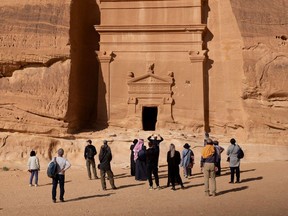The kingdom is spending heavily on hotels, luxury projects and entertainment to transform itself into a hub for tourism

Saudi Arabia said it received a record 30 million foreign tourists last year as the kingdom spends heavily on hotels, luxury projects and entertainment to transform itself into a hub for tourism.
The international arrival numbers, announced by Saudi Tourism Minister Ahmed Al-Khateeb at the World Economic Forum in Davos, mark a rise from the roughly 27.5 million reported by the kingdom in 2023. Those figures include people that traveled to the country for religious pilgrimages, as well as for business and leisure.
While the figures show Saudi Arabia is making further inroads in its tourism drive, the increase in 2024 slowed sharply from 2023 — when arrivals from abroad jumped by more than 60%. The kingdom hopes to draw in 70 million international visitors a year by 2030 and has said it’s counting on the middle-class population in India and China to boost arrivals.
Saudi Crown Prince Mohammed bin Salman has put tourism at the heart of his Vision 2030 strategy to diversify the economy away from oil and create a better life for its young population. It plans to spend almost $1 trillion on the industry over the next decade and has already plowed huge sums of money into entertainment including sports and events to boost the country’s appeal.
The capital of Riyadh also recently opened a metro system in a bid to ease the traffic jams that often complicate journeys visitors make in the city. A new international airport, which is expected to be the biggest in the world upon an expected opening in 2030, is also under construction.
Saudi Arabia is due to host major events like the Asian Winter Games, World Expo and World Cup over the next nine years.
Total tourism figures, which include both foreigners and Saudi citizens traveling in the kingdom, rose to about 115 million from 109 million in 2023.
The tourism industry made up 5% of Saudi Arabia’s gross domestic product at the end of last year, Al-Khateeb said. The country aims to grow that to 10% by the start of the next decade.